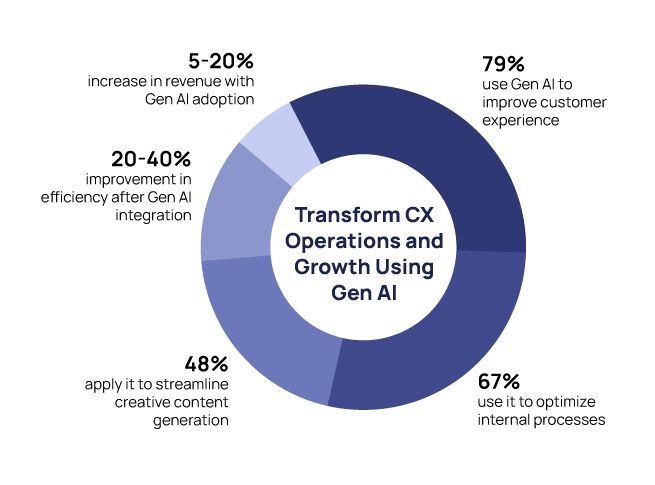
Build Smarter Content Systems Using Generative AI in Marketing

Still treating AI like a shortcut instead of a strategy? You’re missing the real value. Generative AI in marketing helps you cut busywork, adapt quickly, and scale content without chaos. See how marketers use generative AI to collaborate better and launch faster. Scroll down and rethink how you use AI.
Streamlining Content Workflows with Generative AI in Marketing
Creating compelling content today requires more than just creativity; it demands speed, personalization, and the ability to adapt across multiple formats and platforms. As customer journeys grow increasingly complex, you need to deliver the right message at the right moment, whether through a quick meme, an informative article, or a targeted email. The challenge isn’t just producing content; it’s doing so at scale without losing the personal touch that drives engagement. This is where generative AI in marketing steps in.
By automating repetitive tasks, analyzing performance data in real time, and tailoring content to specific audiences, content automation helps streamline your operations. It lets your teams focus on strategy and creativity while ensuring consistency and quality across channels. As content demands rise, using generative AI is quickly becoming less of an option and more of a necessity for staying relevant and efficient. By 2026, an estimated 90% of online content might come from generative AI, making its adoption not just practical, but almost inevitable for content-heavy marketing teams.
Types of Content Generative AI Creates for Marketing Teams
AI content creation is changing how marketing teams work, automating content creation, saving time, and enabling more innovative personalization at scale. From visuals to emails to code, AI handles tasks that once needed entire teams. The goal isn’t just efficiency; it’s speed, flexibility, and testing more ideas faster.
Let’s explore the main AI content types and how marketers are using them to improve campaigns, cut costs, and stay agile:
Marketing Copy That Scales Across Channels
Generative AI writes blogs, emails, ad headlines, product descriptions, and social posts. You can quickly test multiple versions of headlines, CTAs, and product blurbs. It supports marketing with generative AI by making content testing and localization faster especially for global teams.
Visual Assets That Keep up with Campaign Demands
AI tools generate custom graphics, illustrations and banners in minutes. They’re often used as examples of generative AI content in digital marketing, such as A/B test variants, seasonal creative, and rapid mockups. Instead of waiting on designers for every new concept, teams can generate quick visual drafts and refine them later. AI is especially useful for concept art, seasonal themes, and rapid prototyping. It won’t replace designers, but it speeds up workflows and frees up design teams for higher-impact projects.
Video Content Without Full Production Cycles
Short-form videos, animated explainers, and voiceovers can all be generated by AI now. These tools help teams repurpose content quickly and test messaging before full production, showing ways generative AI is used to boost marketing campaigns affordably. AI helps repurpose existing written or visual content into video formats, cutting down time and cost. Teams can also test messaging and visuals in video before committing to expensive production. For always-on campaigns or international markets, AI video tools offer speed and adaptability.
Audio Content for Brand Voice and Ads
Marketers now use AI to create voiceovers, audio ads, podcast intros, and even background music. These are practical types of content AI tools can create for marketers, especially for teams without in-house audio capabilities. Instead of booking voice talent or music licensing, they can generate samples instantly and iterate fast. AI-generated audio helps with experimentation in tone, pacing, and language variations. For audio-first platforms like Spotify or podcast ads, this opens up faster and more cost-effective content production.
Interactive Tools That Support Engagement
AI can help build quizzes, calculators, chatbots, and other interactive web elements with minimal coding. For marketers looking at AI-driven content strategy, these tools offer fast, personalized experiences that drive action. AI also accelerates the development of prototype tools for user testing or campaign support. For content that drives action, not just impressions, AI helps marketers ship faster and test more ideas with fewer resources.
Personalized Experiences That Convert Better
Generative AI can tailor emails, content, and product suggestions to user behavior. These use cases show how marketers use generative AI to increase click-through and conversion rates through better targeting. This kind of targeting improves click-through and conversion rates, especially in e-commerce, CRM, and performance marketing. AI can segment users and generate messaging tailored to behaviors or preferences instantly. Instead of broad messaging, marketers can deliver one-to-one experiences at scale.

Core Ways Generative AI Enhances Content Workflows
The integration of generative AI into your content operations helps speed up production, improve adaptability, and streamline collaboration. It supports your team across every stage from ideation to performance analysis.
Let’s look at how generative AI improves your content workflows:
Expand Creative Output
AI tools help you generate more content, in more formats, with fewer creative blocks.
- Text and Visual Generation: Use Jasper, Rytr, DALL·E 3, or Midjourney to create written content and visuals at scale.
- Video Production: Tools like Synthesia and Pictory turn scripts into video with no need for full production teams.
- Content Variations: Quickly generate alternative versions of existing content, test different tones, or repurpose across formats.
Improve Marketing Agility
AI helps you respond to trends and audience shifts without slowing down workflows. It supports machine learning in marketing by adapting based on real-time signals and campaign performance.
- Real-time Trend Insights: AI can recommend content topics and publishing windows based on live data.
- Faster Turnaround: Adjust messages and campaigns quickly to align with changing preferences.
Strengthen Performance Tracking
AI brings faster, more profound insights into what’s working and what’s not.
- Automated Analysis: Track engagement, conversion, and performance metrics without manual setup.
- Smarter Decisions: Use those insights to shift content strategy, reallocate resources, or localize campaigns.
Streamline Collaboration and Approvals
AI simplifies coordination across teams and reduces delays in the content cycle.
- Faster Reviews: Use AI to edit, summarize, and rewrite drafts, reducing the need for multiple revisions.
- Cross-team Visibility: Shared dashboards and automated updates help everyone stay aligned.
- Centralized Tools: Platforms that combine generation, analytics, and task management make collaboration more efficient.
Benefits of Using Generative AI in B2B Marketing
Generative AI helps your team move faster by automating repetitive tasks, supporting idea development, and simplifying content personalization and optimization. It works alongside human input, not in place of it, to improve speed and efficiency without sacrificing quality.
Here’s what it enables:
Quicker Drafting and Content Variation
You can get from idea to draft faster. Generative AI also helps with reworking long content into smaller formats. Use tools that support natural language generation for generating metadata, summaries, or alternate versions. For content creators juggling multiple formats, AI also speeds up routine writing like product descriptions, FAQs, and metadata. It’s also effective for reworking long-form content into shorter formats such as newsletters, social posts, or summaries. You can tweak tone, fix inconsistencies, or rewrite paragraphs to suit different contexts better. Even visual support like simple illustrations or data graphics can be generated more quickly with the right tools.
Flexible Style and Language Adaptation
AI adapts easily to different writing styles and audience tones. If you’re building content for varied customer segments or across international markets, you may need to adjust voice, messaging, or language quickly. This also makes it easier to respond to timely opportunities like current events or promotions. You can create content at scale for multiple pages, categories, or campaigns while keeping the tone aligned with your brand and audience needs.
Lower Production Costs
Generative AI reduces the effort and cost required for producing a high volume of content. It helps with repetitive writing and smaller creative tasks, freeing up time for planning and strategy. Once you’ve built your system, AI enables you to scale volume without increasing headcount. That’s why it’s often used for AI-generated content like SEO pages, product blurbs, or internal documentation.
Stronger Personalization Capabilities
You can fine-tune AI responses to reflect your audience’s profile, whether that’s based on demographics, behavior, or past engagement. By feeding it information about your target persona or ICP, you can get ideas, content drafts, or improvements that better match what your audience cares about. On a technical level, AI can also support more advanced personalization across web experiences by suggesting dynamic text or adapting content modules based on user inputs or activity.
Creative Idea Expansion
When you’re stuck or trying to approach a topic from a new angle, AI helps you move forward. Even if not every idea is usable, the volume and variety give you a faster way to iterate. With more specific prompts like incorporating brand tone or customer pain points, you’ll get ideas that are more tailored and relevant to your goals. It’s a valuable tool to break creative blocks and speed up brainstorming, especially under time pressure.
Better Support for SEO and Optimization
AI plays a helpful role in search optimization, especially when combined with the correct data. It can structure your content based on what’s ranking for similar topics, identify keyword gaps, and propose ways to match content length or format with search intent. You can generate outlines that align with SERP trends, adjust content to include missed keywords, or rewrite sections that aren’t performing. Used this way, AI supports both content production and performance improvement in one process.
Making Generative AI Work: Problems and Fixes
AI-generated content has changed how many approach content production. It’s fast, scalable, and can mimic various formats well. But the speed and scale come with trade-offs in quality, accuracy, and context.
Here are some of the biggest challenges, and practical ways to address them:
Tone Without Voice
AI can produce grammatically sound and structurally explicit content, but the output often feels flat or impersonal. It lacks the nuance, style, or emotional range that human writers bring naturally. This can make the content feel generic or fail to engage readers.
To fix this, writers should treat AI-generated drafts as starting points. Edit with intention. Add brand voice, point of view, or storytelling elements during post-processing. Treat the output like a rough draft, not a finished product.
Accuracy at Risk
One of the most common risks is AI providing information that sounds plausible but is incorrect. It can hallucinate facts or cite non-existent sources. Since these errors are rarely flagged, they can pass unnoticed if you’re not careful.
To solve this, fact-check everything. Don’t trust citations at face value. Follow the links, validate the claims, and revise anything that doesn’t hold up. AI isn’t a fact-checker, it’s a language generator. Use human review as the safeguard.
Context Blindness
AI doesn’t truly understand the context in which a piece of content will be used. This can lead to irrelevant or even tone-deaf results, especially in sensitive, nuanced, or high-stakes topics. It doesn’t grasp cultural cues, social dynamics, or emotional undercurrents.
Write clear, specific prompts that include audience, intent, and tone. Then review with a critical eye. If you’re working on content that could affect perception or trust, make sure a human editor does a final pass.
Outdated Information
Since most AI models operate on historical training data, they won’t have access to real-time news, trends, or recently published studies. This makes them unreliable for time-sensitive content.
Work around this by pairing AI with manual research. Pull current data yourself and feed it into the prompt. Or use AI for structure and flow, and add up-to-date insights during editing.
Limited Logic and Reasoning
AI doesn’t reason like humans. It can’t evaluate trade-offs, compare complex ideas, or make predictions. You can’t expect it to ‘think through’ a problem. It’s good at rephrasing known information, but struggles with solving ambiguous or logic-driven questions.
Use AI to organize ideas or reword content, not to form conclusions. When reasoning is required, you or your team need to drive that part of the work.
Prompt Friction
Sometimes it takes multiple attempts to get the content you want. If the prompt isn’t clear or detailed enough, the AI’s response may not be effective, resulting in wasted time and effort.
Reduce this friction by building prompt templates for recurring tasks. Experiment until you find what works, then reuse and refine. Document what gets the best results and standardize it across your team if needed.
Best Practices for Improving Accuracy and Impact of Gen AI Content
Generative AI in marketing offers new possibilities for content creation, but using it effectively requires more than automation. To get real value from it, you need a thoughtful approach that blends technology with human insight. AI can support your content efforts, but it shouldn’t dictate them.
Here are some key practices to guide your approach:
Define Your Voice Before Scaling Your Output
Generative AI performs better when it’s trained on clearly defined brand tone, style, and goals. Feed it strong examples of existing content and well-documented voice principles. That way, the output is consistent, context-aware, and easier to refine.
Build Gradually and Test Along the Way
Start small. Use low-risk projects to test how AI fits into your current workflow. Watch for gaps in logic, tone, or structure that might need human correction. With early learning, you’ll be better positioned to scale responsibly and effectively.
Edit with Intent, Not Just for Grammar
AI can miss the mark on nuance, accuracy, or emotional impact. Always review generated content critically. Validate the facts. Sharpen the message. Add your team’s voice and perspective. Treat the draft as raw material, not a finished product.
Bring Back the Human Element
Inject emotional context and storytelling where AI falls short. Use anecdotes, lived experiences, and opinions to make the content relatable. Audiences connect with what feels authentic; AI alone won’t get you there.
Adapt to Changes, Don’t Chase Trends
Keep learning. Generative AI tools change quickly, and their impact on content performance evolves with them. Focus on sustainable improvements to your strategy, not quick wins based on hype or novelty.
Measure What Matters, Not Just What’s Easy
Don’t just count likes or clicks. Look deeper into how your content drives meaningful interaction, emotional reactions, or action. Use these insights to adjust how you use AI in your content planning and production.
Respect Boundaries and Stay Compliant
As new rules around AI-generated content emerge, keep your practices transparent and compliant. Focus on ethical use and clear disclosure when automation is involved. Trust grows when audiences know what to expect.
Future Trends in Generative AI for Content Creation
Generative AI is reshaping how content is produced, customized, and scaled. From writing to immersive media, it’s changing the way brands communicate, and storytellers build experiences. These trends point to how AI will influence the next phase of content strategy and execution.
Let’s explore what’s ahead:
- Hyper-personalization will replace generic messaging, as AI tailors content to individual preferences, behavior, and context in real time.
- Media outlets and brands will increasingly rely on automation for high-volume content tasks, freeing up human creators to focus on strategic and creative work.
- By 2030, this technology may automate up to 30% of hours worked in a day, shifting team structures and opening the door for more high-value, human-led content efforts.
- AI-generated content formats will expand beyond text and images to include dynamic audio, music, video, and virtual environments.
- Real-time responsiveness will become a key feature, where content adapts to user interaction, environment, and emotion.
- Brands will experiment more with interactive and AI-powered storytelling to create deeper engagement.
- Content teams will shift from production-heavy roles to overseeing AI workflows, reviewing outputs, and refining creative direction.
- Quality control and brand alignment will become more critical, with AI outputs requiring human judgment and refinement.
- Ethical questions around authorship, accuracy, and AI bias will shape how this technology is implemented across industries.
“Generative AI is the next big thing in artificial intelligence. It has the potential to revolutionize the way we create content, design products, and solve problems.”
Deliver Better Marketing Results in Less Time with JynAI
JynAI supports the best generative AI tools for content marketing by integrating content generation, collaboration, and insights into one platform. Teams can turn around campaign assets faster, adapt messaging more easily, and keep everything aligned with business goals. Instead of juggling disconnected tools or relying on multiple vendors, marketers use one unified system to ideate, create, and optimize at scale. By minimizing friction and giving teams more control, JynAI becomes an active part of the content process, delivering practical output that improves speed, clarity, and results.
Want to see how JynAI can support your marketing team? Contact us today to start a conversation.
FAQs
How generative AI helps in creating marketing content?
It speeds up content creation, helps brainstorm ideas, and automates repetitive writing. It drafts blogs, emails, captions, and more. AI also supports SEO and personalization, but human editing is still needed for quality and tone.
How AI transforms creative content development?
AI speeds up idea generation, drafts content quickly, and suggests multiple creative angles. It helps teams test concepts faster and iterate with less effort. While it doesn’t replace original thinking, it streamlines early creative work.
What kind of marketing content can be generated by AI?
AI can generate blog posts, emails, social media captions, ad copy, product descriptions, and basic scripts. It also supports SEO content, FAQs, and content summaries. Some tools can create images, videos, or audio, depending on the use case.
How accurate is AI-generated content?
AI content can be accurate when based on well-structured prompts, but it still needs review. It may generate outdated or incorrect facts, especially for recent events. Always fact-check and revise before publishing.
How do I keep AI content on-brand?
Feed the AI with brand guidelines, tone of voice, and examples of past content. Use custom instructions or templates if the tool allows it. You’ll still need to review and edit to maintain consistency and quality.
Are You Ready to Make AI Work for You?
Simplify your AI journey with solutions that integrate seamlessly, empower your teams, and deliver real results. Jyn turns complexity into a clear path to success.



